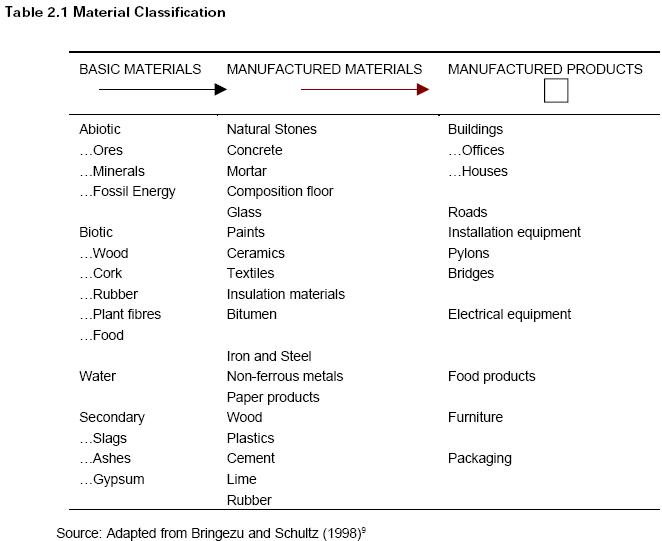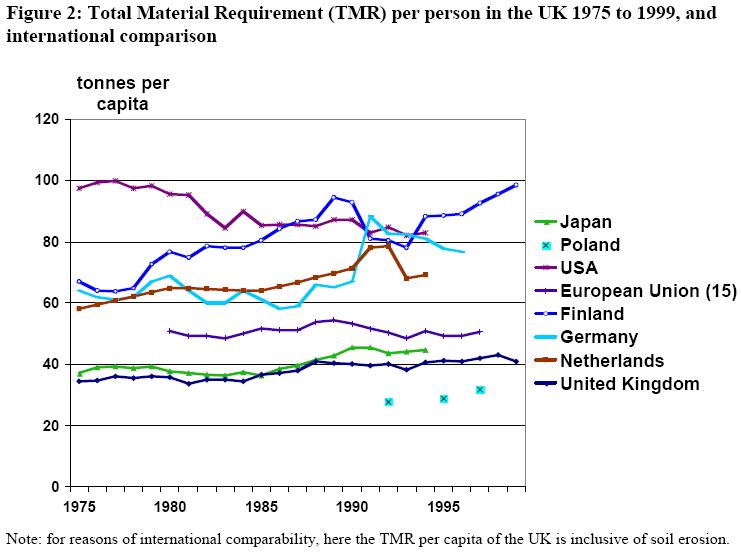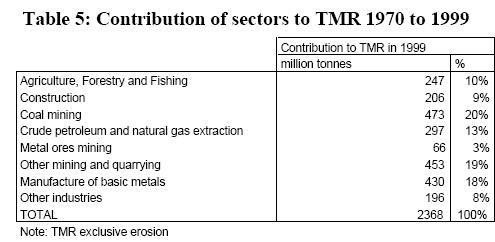Material Flow Analysis
What is Material Flow Analysis?
Material Flow Analysis (MFA) is a quantitative procedure for determining the flow of materials and energy through the economy. It uses Input/Output methodologies, including both material and economic information. It is an accounting system that captures the mass balances in an economy, where inputs (extractions + imports) equal outputs (consumptions + exports + accumulation + wastes), and thus is based on the laws of Thermodynamics.
Material Flow Analysis recognizes that Material Throughput is required for all economic activities and asks whether the flow of materials is sustainable in terms of the environmental burden it creates. It accounts for all materials and energy used in production and consumption, including the hidden flows, or ecological rucksack, of materials that were extracted in the production cycle but which never entered the final products. The physical size of these hidden flows is often many times larger than the flows that end up in actual products.The Table at right provides an overview of the types of materials that can be included in an MFA.
flow of materials is sustainable in terms of the environmental burden it creates. It accounts for all materials and energy used in production and consumption, including the hidden flows, or ecological rucksack, of materials that were extracted in the production cycle but which never entered the final products. The physical size of these hidden flows is often many times larger than the flows that end up in actual products.The Table at right provides an overview of the types of materials that can be included in an MFA.
The identification of wastes is a major issue in MFA, as the purpose of conducting a MFA is to minimize the flow of materials while maximizing the human welfare generated by the flow. Its methodology allows for the monitoring of wastes that are typically unaccounted for in traditional economic analyses. As such, it is a method for evaluating the efficiency of using material resources.
MFA was developed in Europe, largely at the Wuppertal Institute in Germany, and has been adopted as a methodology by the European Union with respect to its sustainable development program. To date the focus of MFA has been primarily regional or national; a variety of MFA studies have been conducted for both developed countries and economies in transition, including Germany, the UK, Japan, Brazil, Venezuela, Chile and China. EU wide studies have also been conducted, and a global MFA is now underway.
Material Flows in the United Kingdom
An MFA study of the UK indicates that the UK has one of the lowest values of  Total Material Requirements (TMR) of any industrial country studied so far, some 40 tonnes per capita in 1999. This is approximately half the TMR for the US and Germany. Over the three decades ending the last millennium, the TMR per capita grew by 5%, and has been constant throughout the 1990’s. Over this period GDP continued to grow, indicating that economic growth can occur without use of additional materials. In terms of resource productivity (GDP per DMI, or Direct Material Inputs), the UK is the second highest in the EU-15.
Total Material Requirements (TMR) of any industrial country studied so far, some 40 tonnes per capita in 1999. This is approximately half the TMR for the US and Germany. Over the three decades ending the last millennium, the TMR per capita grew by 5%, and has been constant throughout the 1990’s. Over this period GDP continued to grow, indicating that economic growth can occur without use of additional materials. In terms of resource productivity (GDP per DMI, or Direct Material Inputs), the UK is the second highest in the EU-15.
While the UK’s TMR is low compared to many other nations, it should be noted that more than half of the TMR is accounted for by hidden flows. The Direct Material Inputs (DMI) is less than half the total. Such a situation indicates an opportunity for an even greater increase in the efficient use of resources.
TMR is divided into domestic and foreign sources. For the UK, domestic resource extraction accounted for 67% of TMR, indicating a high reliance on non-renewable resources made up primarily of fossil fuels and minerals. However, foreign resource requirements are becoming a larger part of TMR and are creating a physical imbalance when hidden flows are considered.  The UK is increasingly relying on materials from trading partners, and shifting the burden of ecological degradation to those partners. However, the UK’s performance in this respect is somewhat better than the EU overall, and considerably better than that of the US.
The UK is increasingly relying on materials from trading partners, and shifting the burden of ecological degradation to those partners. However, the UK’s performance in this respect is somewhat better than the EU overall, and considerably better than that of the US.
TMR can also be analyzed by sector. The largest contributors in the UK are mining and the manufacture of metals. Despite the relatively low TMR, the study reports the need for more recycling, reducing of fossil fuel use in transportation, industry and households, and the dematerialization of the construction industry.
Material Flow Analysis of a Municipality
A variety of MFA studies have also been conducted at the municipal level. One such study for the City of York in the UK combined the MFA with an Ecological Footprint analysis. It found that on average each York resident used approximately 19 tonnes of material per year, approximately half of which is accounted for by hidden flows. The majority of material flows went into housing and road construction.
On York’s output side, some 250,000 tonnes of material went into landfills, and some 70,000 tonnes were recycled. Almost one quarter of the total 3.4 million tones of the city’s “metabolism” were added to the stock of materials in the city over the course of a year.
Strengths of MFA
MFA provides a direct quantitative measure of the actual material and energy flow through an economy. It quantifies the linkage of environmental problems and human activities, and serves as a systems-wide diagnostic procedure related to environmental problems, supports the planning of adequate management measures and provides for monitoring the efficacy of those measures. MFA allows early warning and supports precautionary measures. It detects problem shifting between regions and sectors. MFA provides aggregated information to support decision making. It can be applied at different levels of economic activity.
The procedure makes use of life cycle analysis to ensure that all material flows are accounted for. Its use is associated with a variety of sustainable business development practices such as Zero Waste, Increased Resource Productivity, and Extended Producer Responsibility (see Sustainable Business Practices), indicating that it can offer practical, market based solutions to environmental problems. Its emphasis on the efficiency with which material flows contribute to human welfare is a welcomed redirection of the notion of efficiency away from strictly financial flows.
Limitations of MFA
Efforts to improve MFA are focusing on ensuring adequate data are available, and that there is more standardization of the methodologies across applications.
Relation to Sustainable Scale
MFA is a method for operationalizing the concept of material throughput, and as such is an important contribution to measuring one component of sustainable scale. MFA has proven very useful for demonstrating the negative impacts associated with various specific economic activities. It has highlighted in a very practical way the unsustainability of specific throughputs (e.g. high reliance on non-renewable resources), the incompatibility of absolute levels of input with an equal Earthshare identified within the Ecological Footprint (e.g. Barrett et al 2002), the displacement of ecological burden to trading partners (generally from developed to undeveloped nations), and the enormous wastes involved in specific products or services.
Continued development of this important tool will likely increase its usefulness in linking economic throughput with ecological limits, especially as it is applied to the global level.
References